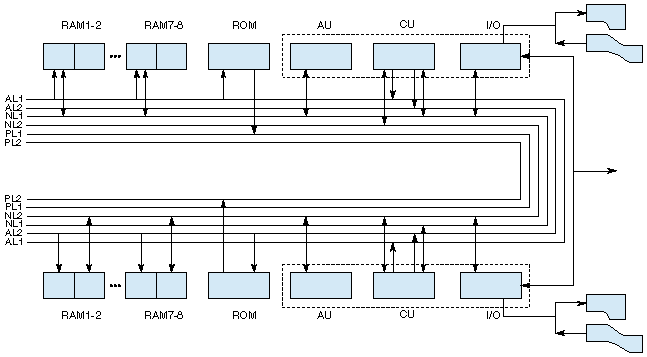Radon Computer
Home → Articles → Radon Computer
- Radon computer.
- Chief designer: S. A. Krutovskikh.
Deputy chief designers and development engineers: S. P. Solovyov, A. I. Savina, A. A. Solovyov, A. P. Antonov, V. S. Barashko, E. I. Klyamko, F. R. Kushnerov, V. I. Levshin, N. G. Maslov, I. B. Mikhailov.
- Designing organization: Research Institute of Electronic Machines (NIEM) of the USSR Ministry of Radio Engineering (since 1986 - Research Institute NII Argon).
- Manufacturer: Moscow SAM factory.
- Completion of development: 1964.
- Beginning of production: 1964.
- Termination of production: 1967.
- Field of application: anti-aircraft defense.
- Number of machines produced: 10.
- Description: Radon computer has been developed in several modifications differing in ROM and RAM capacity. It is a dual-machine system with bus connections using a single-address instruction set. Word length of commands is 24 bits including two check bits, word length of operands is 20 bits including two check bits.
Representation of numbers - fixed point. Number of instruction codes - 64.
Addressing: up to 64 K words including 2,048 - by offset, the rest - by prefixes set up by a special command. Number of index registers - 2.
The instruction set also contains RAM access commands and instructions for controlling the second computer, including stop, mode setup, step, cycle, automatic, processor command address loading and starting in a preset mode.
Each processor has direct access both to its own memory and to the memory of the second machine so that the system can function in dual-machine and dual-processor modes. Both computers are attached to a common exchange bus that connects them to the system control devices.
The peripherals of the machine itself are undeveloped and used only for primary loading, testing and printing of data for further analysis.
- Element base: second-generation, pulse-potential with conductive and transformer coupling based on P16 and P601 transistors.
- Design: 16 racks equipped with individual power supply and control units, an interconnection panel with 320 leaf-type 20-pin sockets connected by plugs which are mounted on end-faces of cells containing from four to eight elements.
- Technology: each element is located on a separate load-bearing printed circuit board. The board is made of plastic by pressing and electroplating grooves and holes with copper.
- Software: a test system and diagnostic programs for troubleshooting by means of running programs on both computers in a required mode and comparing the results of the execution of programs, operations and their parts on both machines.
- Specifications:
- Performance - 67,000 operations per second with 14 ms ROM and RAM cycles.
- Real MTBF - 250 h.
- Recovery time - less than 0.5 h.
- Area necessary to install the computer - at least 150 sq. m.
- Special features: in addition to high reliability and speed, a number of features were implemented in the computer for the first time in Russia:
- transistor-based RAM and ROM;
- CPU with two index registers;
- Highly efficient embedded hardware monitoring combined with error recovery software;
- operation overlapping (pipelining);
- interrupt and priority program switching system;
- dual-processor and dual-machine modes of operation.

Block diagram of Radon computer
ROM = Read Only Memory RAM = Random Access Memory AU = Arithmetic Unit CU = Central Unit I/O = Input/Output AL = Address Lines NL = Number Lines PL = Program Lines EL = Exchange Line



